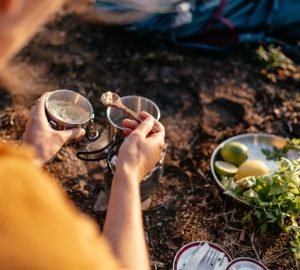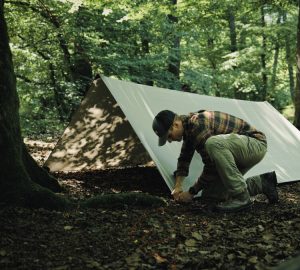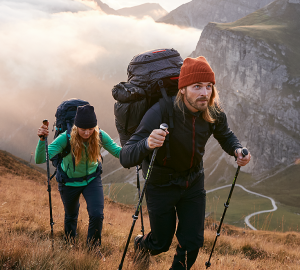Letting the day end next to a silently crackling campfire: more outdoor-romance while trekking or being on the road is hardly possible. Anyway, making fire in the wild isn’t always that easy: you need to know how to make it and what kind of combustion material is necessary, which is especially crucial to not jeopardize yourself or others. Consequently, open fire is not permitted everywhere. Let’s bring some light into the darkness.
Being able to make fire can come quite handy for backpackers: it causes warmth, can be used for cooking and – most importantly – creates perfect outdoor vibes. Before starting the fire, you’d check whether it’s allowed around your place of choice.
Keep in mind: There can be harsh regulations in terms of open fire. You better inform yourself about the rules in your target country beforehand.
A campfire, that’s for sure, leaves traces and destroys a bit of nature. That’s why you might want to use an already existing fire pit – if possible. It’s always the best idea to use official fire places.
Anyway, you need to consider some aspects, still: Is there strong winds? How dry is the soil and the plants nearby? If the area is parched, you better don’t risk making open fire to avoid forest and field fires.
The fire pit – mind the subsoil and the area around
Your fireplace’s subsurface should always be mineral: sand, rocks, gravel or scree. Organic subsoil like peat, rotten twigs or wood humus might continue smoldering some time unnoticed causing a new fire. So please choose your fire pit carefully since you’re responsible in case of a burn.
If you’d kindle your camp fire on grassland it is useful to remove the organic material with a shovel – the area should be greater than the surface of the fireplace. The best way to do so is by removing single pieces of the grassland. The advantage: those pieces can be replanted, and you don’t leave any traces.
You want to get rid of anything burnable which is close to the fire pit – the same goes for wet material. Sparks might light it up. Moreover, you’d mind the wind direction: your tent must never be pitched in the downwind direction of the fire. Sparks might burn holes in the (outer) layer of it.
If possible, try to find a fire place next to a stream, creek or pond so there’s water at hand to distinguish the fire swiftly.

Also interesting: Camping or trekking tent – Which tent type are you?
Collecting fuel – which qualifies best for burning?
After you found the perfect spot for your campfire, you’d start looking for combustible material. To start a fire, you need three different kinds of fuel: tinder, firewood and something you light it with.
Tinder is useful for keeping the first flames alive. Therefore, you can use dry grass, chipped wood, which you can scrape off dry branches with your pocketknife, or dandelion-seeds. You can also use dried leaves or needles.
After that, you need dry twigs, thin branches, dried pine cones or something similar. Spruces-brushwood is particularly useful. Dead branches usually don’t fall off the spruces’ trunk. The good thing about this is they’re not spread all around the area and keep dry even on rainy days.
To keep the fire going, you need thicker branches, which burn for a longer period. These, of course, should be dry as well. The best idea is to collect enough fuel before you start the campfire. In this case you don’t run the risk lacking necessary firewood for your tedious created flames.
How to pile the wood best?
After collecting enough firewood you have to pile the fuel properly. There are different styles. In general: fire needs oxygen. Therefor, it’s crucial to layer everything quite loosely so air can reach the fire from both the sides and below.
If the ground is a bit moist it’s a good idea to start the fire slightly elevated. Simply arrange some branches to one and another on the surface – think of a tiny raft.
Then, you place the tinder in the very middle of this “first-layer”. Around, shaped like a pyramid, you pile thin branches getting bigger with every layer further from the core. It’s essential to leave enough space for oxygen to reach the flames. A pyramid’s shape on the one hand isn’t just sturdy it on the other hand helps to light up the fuel on the top with the more and more growing flames.
Now, the time has come to set the tinder on fire with whatever tool you want – use the lowest level of the pyramid and kindle several spots at once so the flames can grow equally.

Kindle a campfire without a lighter – which tools to use?
Of course, you can simply use matches or a lighter to start a campfire. But matches can get wet if not packed appropriately and lighters might be out of gas. Fortunately, there’re handy alternatives for backpackers.
- Storm matches
Storm matches are usually used for mining or military purposes. They guarantee the lighting of the fuses or explosives used. Even during strong winds, they don’t extinguish due to a special lamination. And, in addition, they’re treated with wax making them waterproof.
By the way, you can make ordinary matches waterproof yourself: just immerse them in liquid wax. - Strike-anywhere matches (don’t)
The clue is in the name: you can easily kindle these matches on any surface available and you don’t need a proper matchbox any more. Yet, this makes them hazardous too: they can inflame themselves unintended when their heads are pressed together within the box. That’s why we don’t recommend them. In fact, you’re not permitted to take them on planes anyway. - Fire stone sets
For starting a fire with fire stones, you need two elements: a piece of steel and a fire stone. If you beat them together, they’ll create sparks which can be used for lighting a fire. Some sets come with magnesium, which you can scrap off and scatter over the fireplace. Magnesium chippings light quite easily making the whole process more comfortable. The advantage is, they are small, waterproof, unbreakable und endurable (for a long time).
Also interesting: Instead of package tours go on adventure holidays – 7 Reasons why you should go on an adventure trip
Extinguishing fire – that’s how
Basically, fire requires to things: oxygen and fuel. To extinguish a campfire, you need to take one of them away – or both.
If you are about to leave or to sleep don’t give more wood to the fire, just let it fade. You can accelerate the process by pouring soil, sand or water into the flames. But don’t pour the water from above, do it carefully from the sides – that’s more effective.
Keep in mind: Always check whether the fire is entirely extinguished before leaving for good. The best way to do so is by using your bare hand: hold it over the ashes with close proximity to feel whether there’s still any heat. Try to leave the area exactly like you found it.
Campfire safety guidelines
- Let’s start with selecting a proper spot: the safety distance between the fire pit and any vegetation or burnable material should at least be 5 times the size of the fire’s diameter. Never less than 5 meters. For tents or pavilions you’d better calculate with an even bigger clearance.
- To prevent the flames or embers from expanding uncontrolled, back your fire place with a stony fringe.
- Don’t let it grow too big.
- To avoid unnecessary smoke or toxic emissions, only use dry and natural wood.
- Never leave the fire unobserved. Check whether there’s still some heat under the ashes before you go. Extinguish the fire properly and leave the place like it used to be. To avoid the outbreak of burns or disturbing others keep flying sparks or smoke development in mind.
- Start piling the fire wood just before lighting it. Otherwise it could be possible that tiny animals start hiding in the stack and be overtaken by the fire.
- Avoid any fire accelerant or gasoline. That’s both redundant and highly dangerous.
- In case a fire gets out of control: alert the fire department immediately.
Good to know: Always have a bucket filled with water or sand prepared to extinguish the fire without any delay if the situation gets out of hand. If there’re no such resources, you must be particularly cautious.
Anyway, with considering all these aspects cautiously, you can simply enjoy a formidable experience of nature around a crackling campfire.







